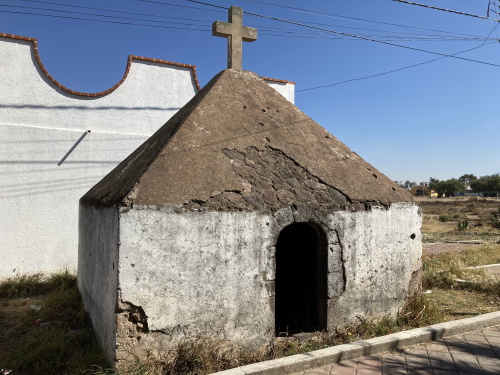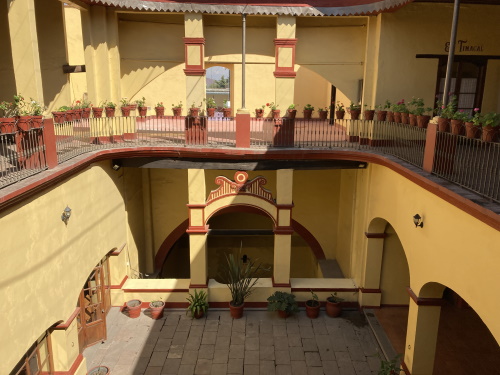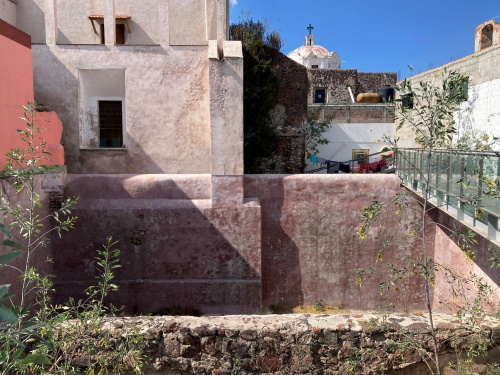Blog WHS Visits
WHS #766: Otumba
I didn’t want to come back from a visit to the Aqueduct of Padre Tembleque with the same story and the same photos as all reviewers before me. So, after digging through the nomination file and looking at the official map, it became clear to me that the two endpoints of the hydraulic system, the towns of Otumba and Zempoala, also are part of the core zone. And luckily there are buses all day long from Mexico City to Otumba. They are run by the same company that goes to Teotihuacan from Area 7 at Terminal Norte bus station. They have a cute map on their website which suggests that you can reach Zempoala with them as well.
After a drive of about 1.5 hours, the bus dropped me at the town entrance and I walked on to the central square. The first (and maybe only) eye-catcher in Otumba is the Church and Convent of the Immaculate Conception, also built under the auspices of Padre Tembleque. The church seems much too big for the town. It has a spacious plaza in front: as in many places in early colonial Mexico, services for the indigenous people were often held in the open air.
Beforehand I had looked up a few places on the map where remains of the water supply to Otumba can still be found. The most striking one is a water tank on the outskirts of town. It is located on a street named after Padre Tembleque. You walk all the way down the street to where the row of houses ends and the fields begin. A large pack of street dogs also has their playground there, but fortunately, they only paid attention to each other. I felt a real sense of accomplishment when the characteristic stone building, with a cross on the roof, came into view. I was so stunned to even find an information panel in Spanish and English next to it, that I forgot to look inside the structure.
My next stop was the Gonzalo Carrasco Regional Museum. Carrasco was a 19th-century painter who lived in a beautiful house at Otumba's central square. I was enthusiastically welcomed by an elderly female guide. They probably don't get foreign visitors here often, but how would I tell her that I wasn't coming for the 19th-century residence at all, but for the water cistern? I couldn’t, so I just went through all the rooms with her. They have beautiful wooden floors and wooden built-in furniture. A lot of stuff was imported from Europe. At the end of the tour, the guide wanted to take a picture with me, as proof that she had a visitor from Holland.
My last stop, after a delicious lunch in a local restaurant along the main road, was the "final reservoir". I discovered this location on Google Maps, where it is called ‘Aljibe Terminal’. It is located somewhere at the back of the Church of the Immaculate Conception. During my search for it, I really noticed how big this religious complex is, it borders 4 streets. The reservoir turned out to be a large stone trough. It also has an information panel, and even the official UNESCO plaque is present here.
Many (including myself) have wondered how Mexico came to nominate this relatively obscure site, which isn’t the oldest, the largest, longest, or otherwise technically most remarkable aqueduct in the world. The nomination file is very thorough and focuses on water management, which never seems to fail to impress the jury. But I actually think the Roman Catholic Mexicans like to believe in the romantic story of Padre Tembleque, whose missionary work was difficult because he couldn't master the native language. But he had a bigger task ahead of him: to heal the people of Otumba by giving them access to clean drinking water.
Els - 30 January 2022
Comments
Els Slots 1 February 2022
Good that you made it to Zempoala, Esteban! I noticed your photo on facebook...
Esteban Cervantes Jiménez 31 January 2022
Great that you visited, Els, and that you provide so interesting insight on your visit to Otumba de Gómez Farías!
I visited Padre Tembleque's WHS on January 4th, just some weeks before you, on a trip that also included Tepotzotlán's Colegio de San Francisco Javier (for the Camino Real de Tierra Adentro WHS), with an initial stop at Arcos de Tepeyahualco, which I found really monumental and definitely a sight that I enjoyed, with the early morning light, despite breaking my record of low temperatures while wearing shorts.
I was also very heavily interested on visiting one of the implied towns and, in my case, it was Zempoala, Hidalgo.
I found Zempoala a very pretty, scenic, town, very quiet and with substantial remains at the 16th century Church and former convent of Todos los Santos (which I also found very big and reminded me of the Popocatepetl Monasteries with its massive atrium, too). The aljibe of the middle of the convent was what I was mostly looking to visit (as it appears in the Advisory Body Evaluation), and being there was my loneliest visit during my 18 days in Mexico, one could even hear the doves on the sides of the church.
I was intending to also visit the former Hacienda Los Arcos, which is the other "emerged" section of the aqueduct, but couldn't in the end. However, it is very reachable from Zempoala and I think it would be interesting if a WHS visitor is able to fit that hacienda in its itinerary.
Overall, it was a great experience and I hope to write a review sometime soon.


